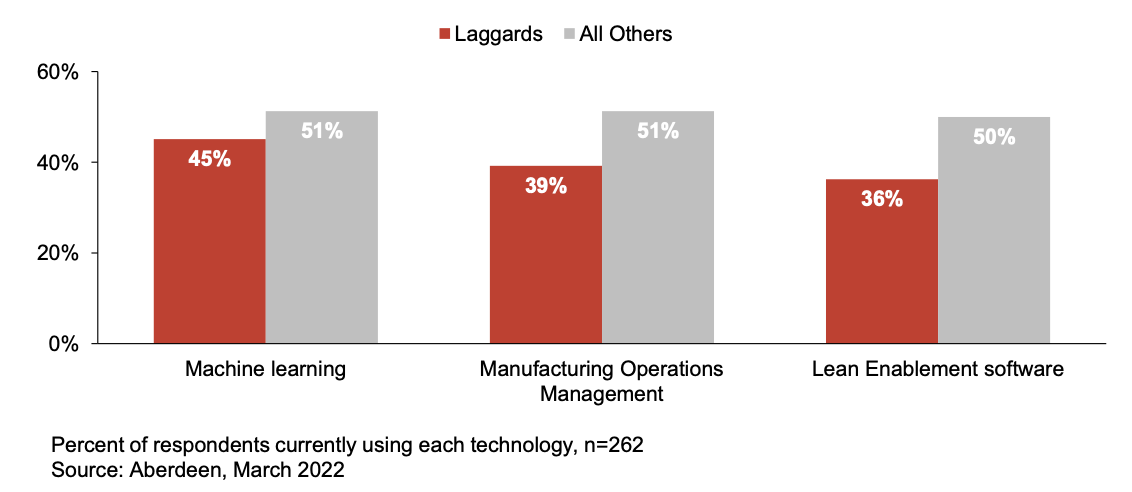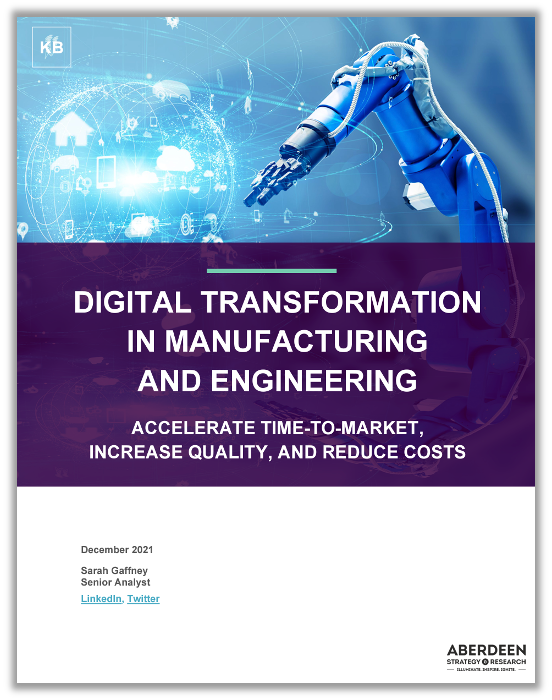This is the fourth and final post in Aberdeen’s Digital Transformation Blog Series. If you find your organization is lagging behind the competition in critical business metrics like revenue, time-to-market, quality, or cost targets, this post reveals some common pitfalls and how to avoid them. It also outlines the steps you can take to improve your operational effectiveness and suggests how to work toward becoming a top performer.
The increasing pace of innovation consistently drives manufacturers to improve their operations. The competitive, high-tech environment in manufacturing and engineering is difficult to keep up with, and some organizations lag behind due to inefficiencies from manual processes and lack of visibility into their operations and market needs. But the first step in making improvements is awareness. These organizations should assess their processes to determine why they are falling behind, and then they can develop a plan for their transformation to eventually become leaders in the industry. The main areas they should look to first are cost, talent, and data management.
Aberdeen defines the following groups in our latest analysis of survey responses from 262 manufacturing and engineering leaders, based on their performance in time-to-market, quality, cost, and revenue:
- Top Performers: Hitting time-to-market and quality and cost targets as well as revenue targets [Learn more about Top Performers in the previous blogpost: 3 Key Metrics to Boost Revenue & Profitability in Manufacturing ]
- Falling Flat with Revenue: Hitting time-to-market and quality and cost targets but missing revenue targets [Learn more about manufacturers who are Falling Flat in the previous blogpost: How Top Manufacturers Transform Operational Excellence into Revenue Growth]
- Missing the Mark: Missing time-to-market, quality, and cost targets but hitting revenue targets [Learn more about manufacturers who are Missing the Mark in the previous blogpost: Optimize Manufacturing Operations for Long-Lasting Organizational Success]
- Laggards: Missing time-to-market, quality, cost, and revenue targets
Unlike those who are Top Performers, Falling Flat with Revenue, or Missing the Mark, Laggards are not consistently achieving any of their operational or financial goals. These companies are struggling with some of the top market pressures more than other organizations. Aberdeen research shows that in comparison to All Others, Laggards are more likely to cite rising operating costs, attrition of skilled workers, and time spent searching for information as top challenges.

Percent of respondents, n=262
Source: Aberdeen, March 2022
These organizations are not too far behind in their adoption of critical manufacturing and engineering technologies, but where they do fall short is in strategically leveraging those technologies to improve their people, processes, and performance. They need to reevaluate how they are utilizing their tech stack and the effectiveness of these use cases to determine areas for improvement.
Reduce Operating Costs
The rising cost of raw materials has been exacerbated by current events like the chip shortage and the Russia-Ukraine crisis. Now more than ever, manufacturers should be looking to optimize their raw material utilization through lean manufacturing and gain visibility into their operations to identify areas to cut costs and minimize waste. Laggards are behind All Others when it comes to the use of Manufacturing Operations Management (MOM) solutions and Lean Enablement software – two critical systems for reducing operating costs.

By leveraging these technologies to target inefficient areas of development and production, Laggards can put their resources toward more important initiatives. Machine learning amplifies the impact of these technologies by identifying patterns in the data and developing algorithms for scheduling, machine uptime, and volume production to optimize material utilization and operational efficiency.
Establish Initiatives to Close the Talent Gap
Manufacturing and service organizations have been plagued by the skills gap for decades as older workers continue to retire and the skills required to operate new technology become more complex. Laggards in particular struggle with the attrition of skilled workers and the ability to find the skills they need in today’s available talent pool.
Instead of trying to hire for this ever-changing set of skills, organizations can look to invest in technologies to support training for new workers, capture the domain knowledge from experienced workers, and set up remote assistance for experienced workers to easily aid newer technicians in the factory and field. Augmented reality (AR) is one solution that can help with that. Aberdeen research shows that Laggards are currently behind All Others in their adoption of AR, 30% to 38%, but implementation of AR can go a long way toward speeding up time-to-proficiency, enhancing safety training, and reducing cost and time of hiring.
Performance analytics also help manufacturers better understand the skills within their organization and the skills they need to improve that performance. Additionally, talent analytics can help identify what skills are out there in the market, which skills are most valuable, and how the increasing pace of innovation is changing skill prioritization.
Streamline Data Management Processes
Another area to consider when planning digital transformation is data management. Laggards need to clean up their data infrastructure to support strong and fast analyses of manufacturing, engineering, and business data. They are currently behind All Others in their implementation of a centralized repository for manufacturing data, dashboards and BI tools, and visibility into comprehensive manufacturing metrics.

Having a single source of truth significantly reduces the need to go to multiple applications to access data, ultimately reducing time spent searching for information and improving data quality. Visualization tools to analyze manufacturing data are critical for gaining insight into which processes are working effectively and which need to be reevaluated, and visibility into operational metrics contributes to that cycle of continuous improvement.
Deploy the Right Strategies to Plan Your Transformation Today
To find greater success in revenue, time-to-market, quality, and cost, organizations who are planning their transformation journeys should look to:
- Reduce operating costs by optimizing raw material utilization and efficiency
- Establish initiatives to close the talent gap through the use of analytics and AR
- Streamline data management processes to develop a strong base for analytics and decision-making.
By keeping these three strategies in mind today, manufacturers and engineering executives can make the changes necessary to stay competitive with industry leaders.
No matter if your organization is a Top Performer, Falling Flat with Revenue, Missing the Mark, or a Laggard, there is always room for improvement. The key is finding out where to start. You can determine which next steps are best for your organization by comparing your performance to these four groups and identifying which strategies make the most sense for your organization based on your existing tech stack and how your manufacturing and engineering teams are leveraging those solutions.
Related Research
Gain expert insights on how to optimize manufacturing and engineering operations. Read the full knowledge brief below and contact Aberdeen today.




